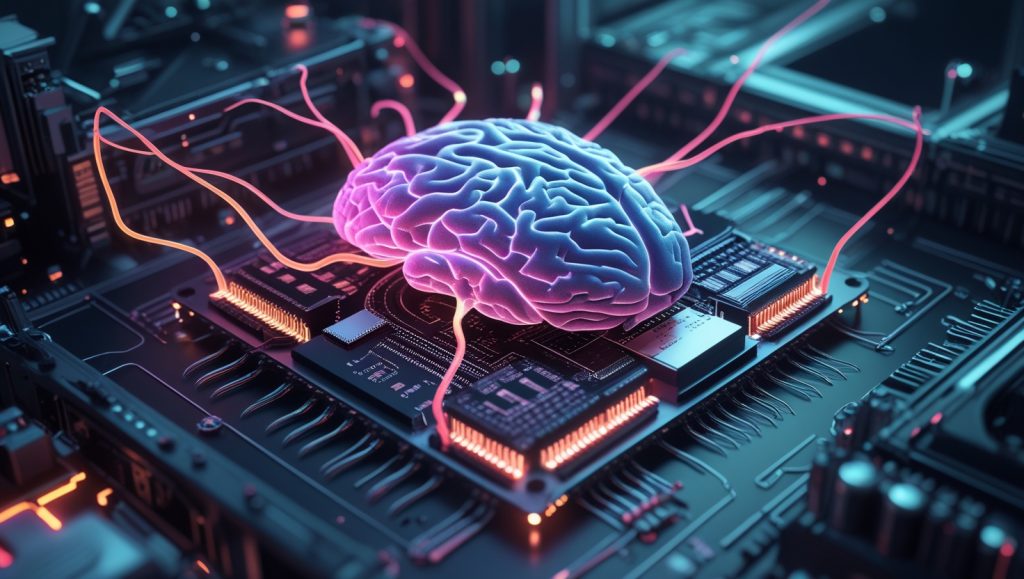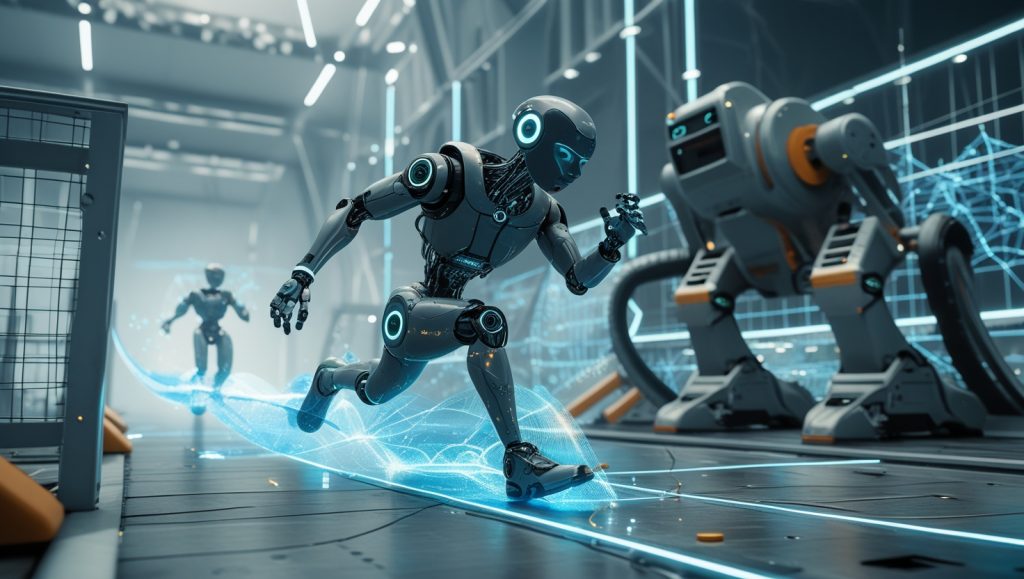Imagine a computer that doesn’t just crunch numbers but thinks—mimicking the chaotic brilliance of your brain, firing signals only when needed, and sipping power like a hummingbird at rest. That’s the promise of neuromorphic AI chips, a technology poised to redefine artificial intelligence in 2025 and beyond. Rooted in the quest to emulate the human brain’s neural networks, these chips are more than a buzzword—they’re a bold leap toward smarter, greener, and faster computing. As AI’s appetite for energy balloons—projected to double by 2026, per industry forecasts—traditional silicon is buckling under the strain. Enter neuromorphic AI chips, blending neuroscience and engineering to tackle problems conventional chips can’t touch.
I first stumbled across this tech while chatting with a robotics engineer at a Singapore tech expo last year. He described how neuromorphic AI chips powered a drone that navigated a cluttered warehouse with eerie precision—using a fraction of the energy a standard GPU would guzzle. It wasn’t just cool; it was a glimpse into a future where machines don’t just compute but adapt. In this article, we’ll unpack why neuromorphic AI chips are the next big thing, diving into their mechanics, real-world wins, and the hurdles they face. Buckle up—this is tech with attitude.
What Are Neuromorphic AI Chips, Anyway?

At their core, neuromorphic AI chips are hardware designed to mimic the brain’s architecture—think neurons and synapses, not just transistors and clocks. Unlike traditional CPUs or GPUs, which process data sequentially and burn energy like a furnace, these chips operate on a spiking neural network (SNN) model. Data flows in bursts—or “spikes”—only when triggered, slashing power use while boosting efficiency. It’s a radical shift from the von Neumann bottleneck, where memory and processing are split, slowing everything down.
Take Intel’s Loihi 2, for instance. Packing over a million artificial neurons, it’s built to handle parallel tasks with a stingy 1 watt of power—compared to a GPU’s 400-watt feast. IBM’s TrueNorth, another pioneer, boasts 256 million synapses and sips just 70 milliwatts. These aren’t your grandpa’s microchips; they’re brain-inspired powerhouses. The secret? Colocating memory and computation, just like the brain does, so data doesn’t waste time commuting.
Why does this matter? Because AI is hungry. Training a single large language model like ChatGPT can emit carbon equivalent to 300 round-trip flights between New York and San Francisco, according to MIT research. Neuromorphic AI chips promise to tame that beast, making AI sustainable without sacrificing smarts.
1 Why Neuromorphic AI Chips Are a Powerhouse for Efficiency

Let’s get real: energy efficiency isn’t just a nice-to-have—it’s a survival trait for tech in 2025. The human brain runs on 20 watts, roughly the juice of a dim light bulb, yet performs 10^16 operations per second. Compare that to a high-end Nvidia GPU, chugging 400 watts for 10^15 operations. The brain’s 100,000-fold efficiency edge isn’t magic; it’s design. Neuromorphic AI chips borrow that blueprint, using sparse, event-driven processing to cut waste.
A standout example is Intel’s Hala Point system, unveiled in 2024. With 1.15 billion neurons—matching an owl’s brain—it delivers 20 petaops of performance at a fraction of the energy cost of traditional supercomputers. Researchers at Sandia National Labs found neuromorphic systems can slash energy use by 100 times for tasks like image recognition compared to GPU setups. That’s not just a win for the planet; it’s a lifeline for edge devices like drones or wearables that can’t lug around a power plant.
But it’s not all rosy. Scaling these chips to rival the brain’s 86 billion neurons is a Herculean task. Current designs are still prototypes, not mass-market miracles. Still, the efficiency angle is why neuromorphic AI chips are turning heads—and wallets—in Silicon Valley and beyond.
2. Why Are Neuromorphic AI Chips Perfect for Real-Time Adaptation?

Here’s where things get tricky. Traditional AI learns in batches—think of it as cramming for an exam, then forgetting half the material. Neuromorphic AI chips, though, adapt on the fly, as a street-smart kid picking up tricks mid-game. This is thanks to their spiking neural networks, which tweak connections in real time based on incoming data—a process called plasticity.
Consider a case from the Singapore Robotics Ecosystem. A neuromorphic-powered robot at Nanyang Technological University navigated a dynamic obstacle course, adjusting its path as objects moved—all without a cloud connection. Compare that to a GPU-based bot, which might stutter, waiting for server updates. The difference? Neuromorphic AI chips don’t just process; they learn as they go, ideal for autonomous systems like self-driving cars or rescue drones.
This adaptability shines in unpredictable settings. A 2025 study from Nature Electronics showed a neuromorphic chip outperforming deep learning models in real-time video analysis by 50 times, using a tenth of the power. It’s fearless tech—unafraid to ditch the training wheels and tackle the wild.
3. How Neuromorphic AI Chips Are Reshaping Industries
The ripple effects of neuromorphic AI chips are hitting hard across sectors. Let’s break it down with some real-world grit.
In healthcare, neuromorphic AI chips are powering next-gen diagnostics. At UC San Diego, the NeuRRAM chip—co-developed with Intel—runs AI models for brain signal analysis at a fraction of the energy cost of traditional systems. Doctors can monitor epilepsy patients in real time, spotting seizures before they escalate. It’s a lifeline that doesn’t drain hospital grids.
Robotics is another frontier. My expo buddy’s drone? It’s part of a trend. The 2025 Robot Dog Navigation Rescue project uses neuromorphic AI chips to guide canine-inspired bots through disaster zones, sniffing out survivors with uncanny speed. Unlike GPU-reliant robots, these pups don’t overheat or lag—they think fast and move faster.
Then there’s entertainment. Hollywood’s eyeing neuromorphic AI chips for immersive experiences. A startup called BrainChip powers VR systems that adapt to user reactions in real time, tweaking scenes based on eye movements or heart rate. It’s not just cool—it’s profitable, with analysts pegging the neuromorphic market at a 21.2% CAGR through 2030, per Exoswan.
But it’s not all sunshine. The gaming angle—like Call of Duty—stays separate here. Neuromorphic AI chips aren’t yet optimized for twitchy, graphics-heavy shooters. Their strength lies in adaptive, low-power tasks, not rendering 4K explosions. Mixing those worlds would be like putting a racecar engine in a tractor—wrong tool, wrong job.
4. Why Neuromorphic AI Chips Face Big Challenges (And Why That’s Okay)

No tech is perfect, and neuromorphic AI chips have their share of bruises. First, scale. Intel’s Hala Point is impressive, but 1.15 billion neurons is a speck next to the brain’s 86 billion. Building chips with that density is a physics nightmare—materials like memristors and phase-change memory are promising but tricky to mass-produce.
Second, software. Traditional coding doesn’t play nice with spiking neural networks. Developers need new tools—like Nengo, a Python-based compiler—to unlock neuromorphic potential. It’s a steep learning curve, and the ecosystem lags behind giants like TensorFlow. A WIRED piece noted this gap could stall adoption unless big players step up.
Third, cost. These chips are bleeding-edge, not budget-friendly. A Quanta Magazine report pegged NeuRRAM’s development as a multi-year, multi-million-dollar slog. For small businesses, that’s a tough pill—especially when GPUs, flaws and all, are cheaper and proven.
Yet, these hurdles aren’t dealbreakers. They’re growing pains. The fight against climate change leans on neuromorphic AI chips for efficient solutions—like optimizing renewable energy grids. The “why” here is survival: we can’t afford to keep burning energy like it’s 1999. Challenges just mean the revolution’s still cooking.
5. Why Neuromorphic AI Chips Are the Future of AI Ethics
Here’s a curveball: neuromorphic AI chips could reshape how we think about AI’s moral compass. Their edge-computing chops—processing data locally—cut reliance on cloud servers, boosting privacy. Imagine a smartwatch that analyzes your health without pinging Google’s servers. That’s neuromorphic in action, per a 2025 ScienceDaily feature.
But there’s a flip side. Their brain-like adaptability raises spooky questions. If these chips learn too well, could they mimic human biases—or worse, evolve beyond our control? A Nature review warned that scaling neuromorphic systems might outpace our ability to govern them. It’s not sci-fi; it’s a real risk if we don’t set guardrails.
The ethical “why” is accountability. We need neuromorphic AI chips to empower, not endanger. Companies like Intel and IBM are collaborating with ethicists—via initiatives like the Intel Neuromorphic Research Community—to ensure this tech doesn’t go rogue. It’s a tightrope, but one worth walking.
Real-World Case: The Drone That Thinks Like a Pilot
Let’s ground this with a story. In 2024, a team at Australia’s ICNS deployed DeepSouth, a neuromorphic system with 228 trillion synaptic operations per second—rivaling a human brain. They hooked it to a drone tasked with mapping a wildfire-ravaged forest. Unlike GPU-powered peers, which choked on smoke-obscured data, DeepSouth’s neuromorphic AI chips adapted instantly, rerouting around blind spots and delivering a 3D map in hours. Firefighters saved lives with that intel, and the system used less juice than a laptop.
That’s the magic of neuromorphic AI chips: they don’t just compute—they reason. It’s why they’re not just a trend but a necessity for 2025’s chaos.
Wrapping Up: The Neuromorphic Revolution Awaits
Neuromorphic AI chips are more than a tech upgrade—they’re a paradigm shift. They slash energy costs, adapt like living things, and promise a smarter, greener future. From healthcare to robotics, their fingerprints are everywhere, even if scale and software kinks hold them back. The fearless truth? They’re not perfect, but they’re damn close to what AI needs to survive its own gluttony.
Want to dig deeper? Check out why robotics in entertainment might lean on these chips next—or explore IBM’s neuromorphic journey at IBM Research. The brain’s secrets are unlocking, and neuromorphic AI chips are the key. Are you ready for the ride?
